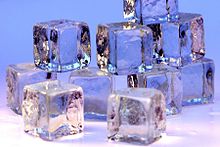Ice cube: Difference between revisions
Dinamik-bot (talk | contribs) m [r2.6.5] robot Adding: he:מגש קוביות קרח |
Undid revision 406058145 by Dinamik-bot (talk) |
||
| Line 59: | Line 59: | ||
[[es:Cubito de hielo]] |
[[es:Cubito de hielo]] |
||
[[fr:Glaçon]] |
[[fr:Glaçon]] |
||
[[he:מגש קוביות קרח]] |
|||
[[nl:IJsblokje]] |
[[nl:IJsblokje]] |
||
[[ja:クラッシュドアイス]] |
[[ja:クラッシュドアイス]] |
||
Revision as of 11:48, 6 January 2011
This article needs additional citations for verification. (October 2009) |


Ice cubes are small, roughly cube-shaped pieces of ice, conventionally used to cool beverages. Ice cubes are often preferred over crushed ice because they melt more slowly; they are standard in mixed drinks that call for ice, in which case the drink is said to be "on the rocks."
Ice cubes are produced domestically by filling an ice cube tray with water and placing it in a freezer. Many freezers also come equipped with an icemaker, which produces ice cubes automatically and stores them in a bin from which they can be dispensed directly into a glass. Ice cubes out of a tray are generally longer and thinner, requiring less force to remove them from the tray and thereby reducing the likelihood of the cube becoming stuck in the dispenser.
There are also dedicated ice-maker machines used to produce ice cubes for laboratories and academic use. Ice cubes are also produced commercially and sold in bulk; these ice cubes, despite their name, are often cylindrical, and may have holes through the center. An interesting characteristic of commercially made ice cubes is that they are completely clear, lacking the clouding found in the center of domestically made ice cubes.
Cloudy ice cubes result when water is frozen quickly, or when the water is high in dissolved solids. When water is cooled to its freezing point, and ice starts to form, dissolved gases can no longer stay in solution and come out as microscopic bubbles. However, as ice floats in water, once there is enough ice to form a layer on the surface, the ice layer traps all bubbles within the ice cube. Commercial ice-makers use a flowing source of purified water to make ice with cooling elements at the bottom, allowing the bubbles to be washed away from the top as the cube grows.
Melting ice cubes sometimes precipitate white flakes, commonly known as "floaties". This is calcium carbonate which is present in many water supplies and is completely harmless.[citation needed]
Ice cubes can also be crushed or sheared into irregularly-shaped flakes, adding an interesting aesthetic effect to some cocktails. Crushed ice is also used when faster cooling is desired, since the rate of cooling is governed by the number and average radius of the ice particles.[1]
Ice Cube Predecessor

American physician and humanitarian John Gorrie built a refrigerator in 1844 with the purpose of cooling air. His refrigerator produced ice which he hung from the ceiling in a basin. Gorrie can be considered the creator of ice cubes, even though his aim was not to cool drinks. Rather, he used the ice to cool the ambient room temperature. During his time, a dominant idea was that bad air quality caused disease. Therefore, in order to help treat sickness, he pushed for the draining of swamps and the cooling of sickrooms.
Ice cube tray

Ice cube trays are designed to be filled with water, then placed in a freezer until the water freezes to ice, producing ice cubes. Trays are often flexible, so the frozen cubes can be easily removed by flexing the tray. An alternative system is an aluminum tray with a lever that raises the ice cubes, freeing them from the tray. A motorized version of this is found in most automatic ice-making freezers.
While the usual shape of the ice 'cube' is roughly cubical, there are trays that dispense hemispherical or cylindrical blocks. These are commonly referred to as ice tubes. Some novelty trays produce blocks of ice in seasonal, festive or other shapes.
Recent demand for premium, safe drink ice has created a new niche market for disposable ice trays which can be cost- effectively transported or stored at room temperature, whilst protecting the consumer from contaminants such as fecal matter, E. Coli or fertilizer residue commonly found in mis-handled ice cube trays and un-safe water supplies.[2]
The first flexible stainless steel, all-metal ice cube tray was created by Guy L. Tinkham in 1933. The tray bent sideways to remove the ice cubes.
The first rubber ice cube tray was invented by Lloyd Groff Copeman. One day in 1928, while walking through some woods collecting sap for maple syrup, Copeman noticed that slush and ice flaked off his rubber boots rather than adhering to them. Having recalled this incident over lunch with his patent attorney, he conducted experiments using rubber cups. Later, he set about designing and then patenting different types of tray: a metal tray with rubber separators, a metal tray with individual rubber cups, and a tray made completely of rubber.[3]
See also
References
- ^ Rauch, Jeffrey (1975). "The mathematical theory of crushed ice". Partial differential equations and related topics (Program, Tulane Univ., New Orleans, La., 1974). Berlin, New York (the state): Springer-Verlag. pp. 370–379. MR0427863.
{{cite book}}: CS1 maint: postscript (link) - ^ "After Bottled Water? Purified Ice Cubes". Retrieved 2008-06-03.
- ^ "www.lloydcopeman.com: Biography" (PDF).
